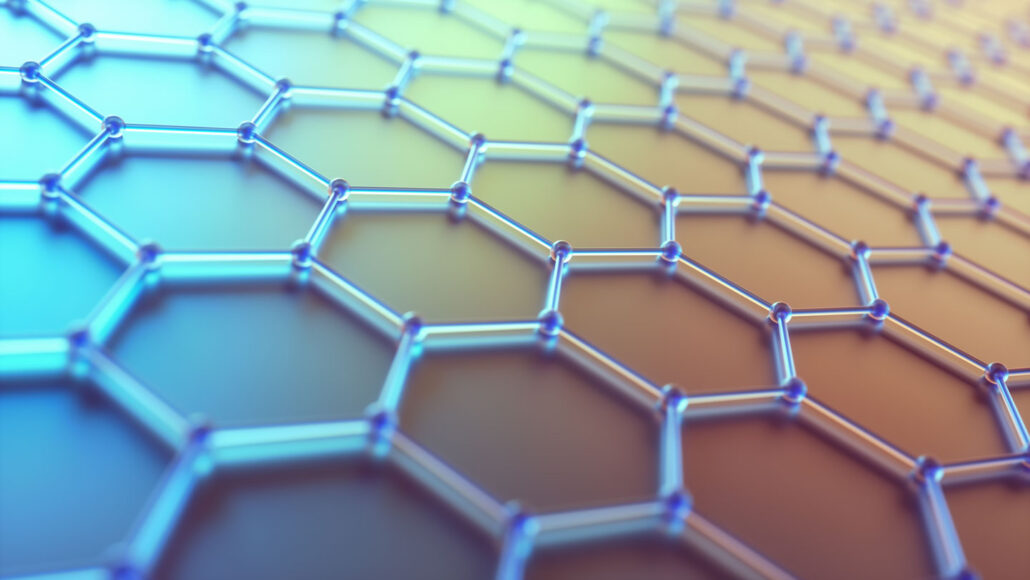2-D: Short for two-dimensional. This term is an adjective for something in a flat world, meaning it has features that can be described in only two dimensions — width and length.
application: A particular use or function of something.
atmosphere: The envelope of gases surrounding Earth, another planet or a moon.
atom: The basic unit of a chemical element. Atoms are made up of a dense nucleus that contains positively charged protons and uncharged neutrons. The nucleus is orbited by a cloud of negatively charged electrons.
boron: The chemical element having the atomic number 5. Its scientific symbol is B.
carbon: A chemical element that is the physical basis of all life on Earth. Carbon exists freely as graphite and diamond. It is an important part of coal, limestone and petroleum, and is capable of self-bonding, chemically, to form an enormous number of chemically, biologically and commercially important molecules.
carbon dioxide: (or CO2) A colorless, odorless gas produced by all animals when the oxygen they inhale reacts with the carbon-rich foods that they’ve eaten. Carbon dioxide also is released when organic matter burns (including fossil fuels like oil or gas). Carbon dioxide acts as a greenhouse gas, trapping heat in Earth’s atmosphere. Plants convert carbon dioxide into oxygen during photosynthesis, the process they use to make their own food.
cement: To glue two materials together with a binder that hardens into a rigid solid, or the viscous glue used to affix the two materials. (in construction) A finely ground material used to bind sand or bits of ground rock together in concrete. Cement typically starts out as a powder. But once wet, it becomes a mudlike sludge that hardens as it dries.
chemical: A substance formed from two or more atoms that unite (bond) in a fixed proportion and structure. For example, water is a chemical made when two hydrogen atoms bond to one oxygen atom. Its chemical formula is H2O. Chemical also can be an adjective to describe properties of materials that are the result of various reactions between different compounds.
computer chip: (also integrated circuit) The computer component that processes and stores information.
conductor: (in physics and engineering) A material through which an electrical current can flow.
current: (in electricity) The flow of electricity or the amount of charge moving through some material over a particular period of time.
electricity: A flow of charge, usually from the movement of negatively charged particles, called electrons.
electronics: Devices that are powered by electricity but whose properties are controlled by the semiconductors or other circuitry that channel or gate the movement of electric charges.
germ: Any one-celled microorganism, such as a bacterium or fungal species, or a virus particle. Some germs cause disease. Others can promote the health of more complex organisms, including birds and mammals. The health effects of most germs, however, remain unknown.
MXenes: A class of super-thin, layered synthetic nanomaterials that are planar in structure (like sheets of paper). They are made from alternating layers of atoms. One layer is made of linked atoms of some transition metal (which is referred to as M). The next layer will be linked atoms of another element that's referred to as X (which is typically carbon, nitrogen or bromine). Being so thin, these materials have an enormously high surface area, relative to their mass. Many also are chemically reactive.
nitrogen: A colorless, odorless and nonreactive gaseous element that forms about 78 percent of Earth's atmosphere. Its scientific symbol is N. Nitrogen is released in the form of nitrogen oxides as fossil fuels burn. It comes in two stable forms. Both have 14 protons in the nucleus. But one has 14 neutrons in that nucleus; the other has 15. For that difference, they are known, respectively, as nitrogen-14 and nitrogen-15 (or 14N and 15N).
phosphorus: A highly reactive, nonmetallic element occurring naturally in phosphates. Its scientific symbol is P. It is an important part of many chemicals and structures that are found in cells, such as membranes, and DNA.
semiconductor: A material that sometimes conducts electricity. Semiconductors are important parts of computer chips and certain new electronic technologies, such as light-emitting diodes.
ultraviolet: A portion of the light spectrum that is close to violet but invisible to the human eye.
ultraviolet light: A type of electromagnetic radiation with a wavelength from 10 nanometers to 380 nanometers. The wavelengths are shorter than that of visible light but longer than X-rays.








